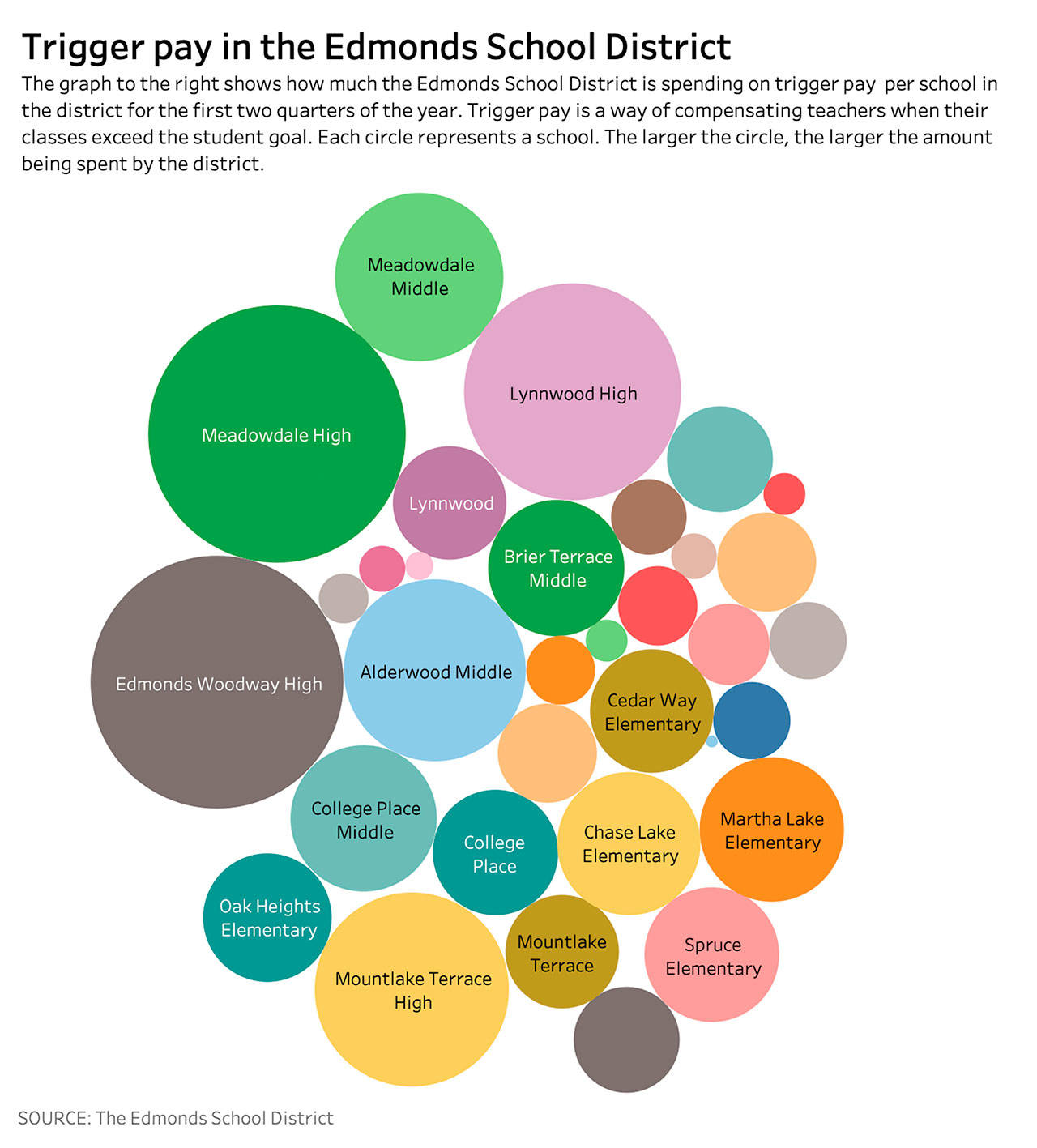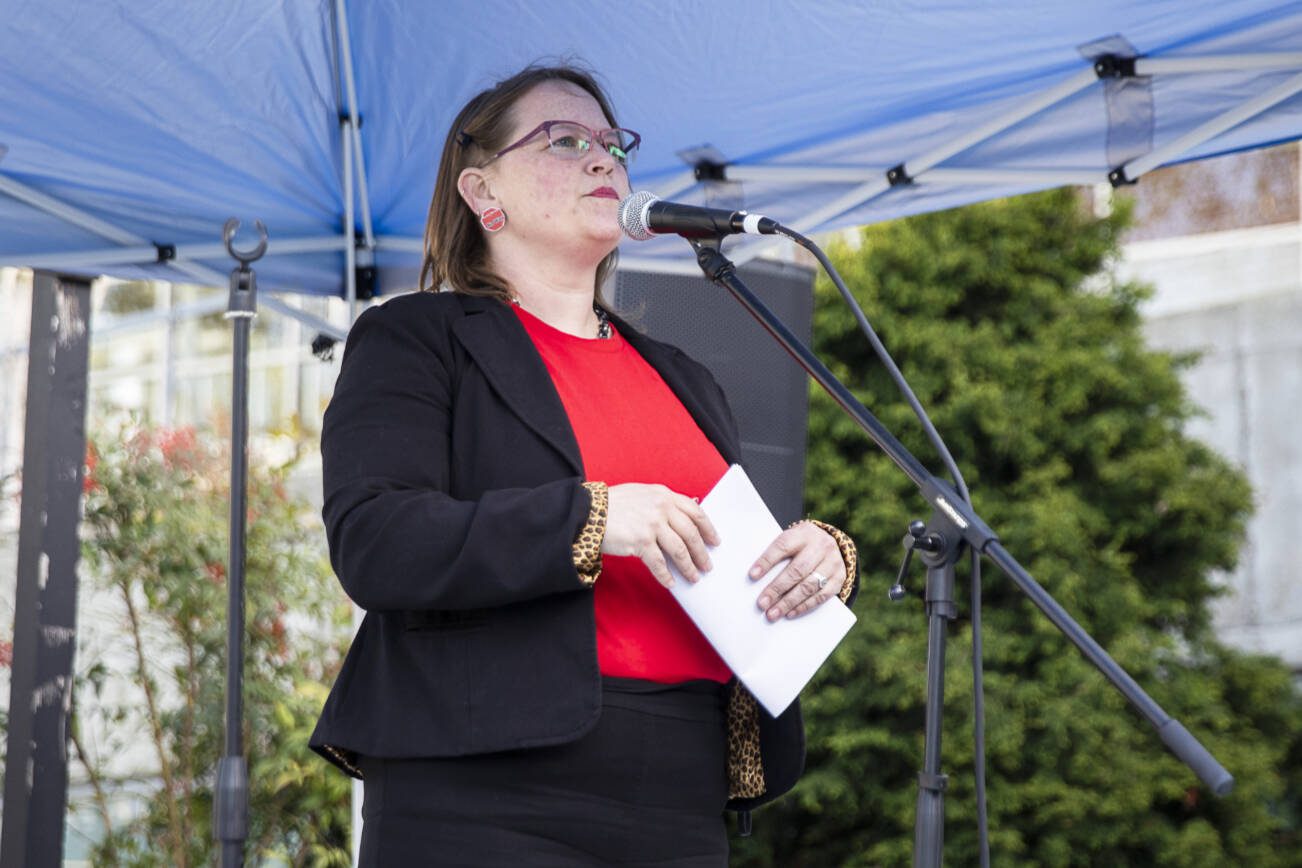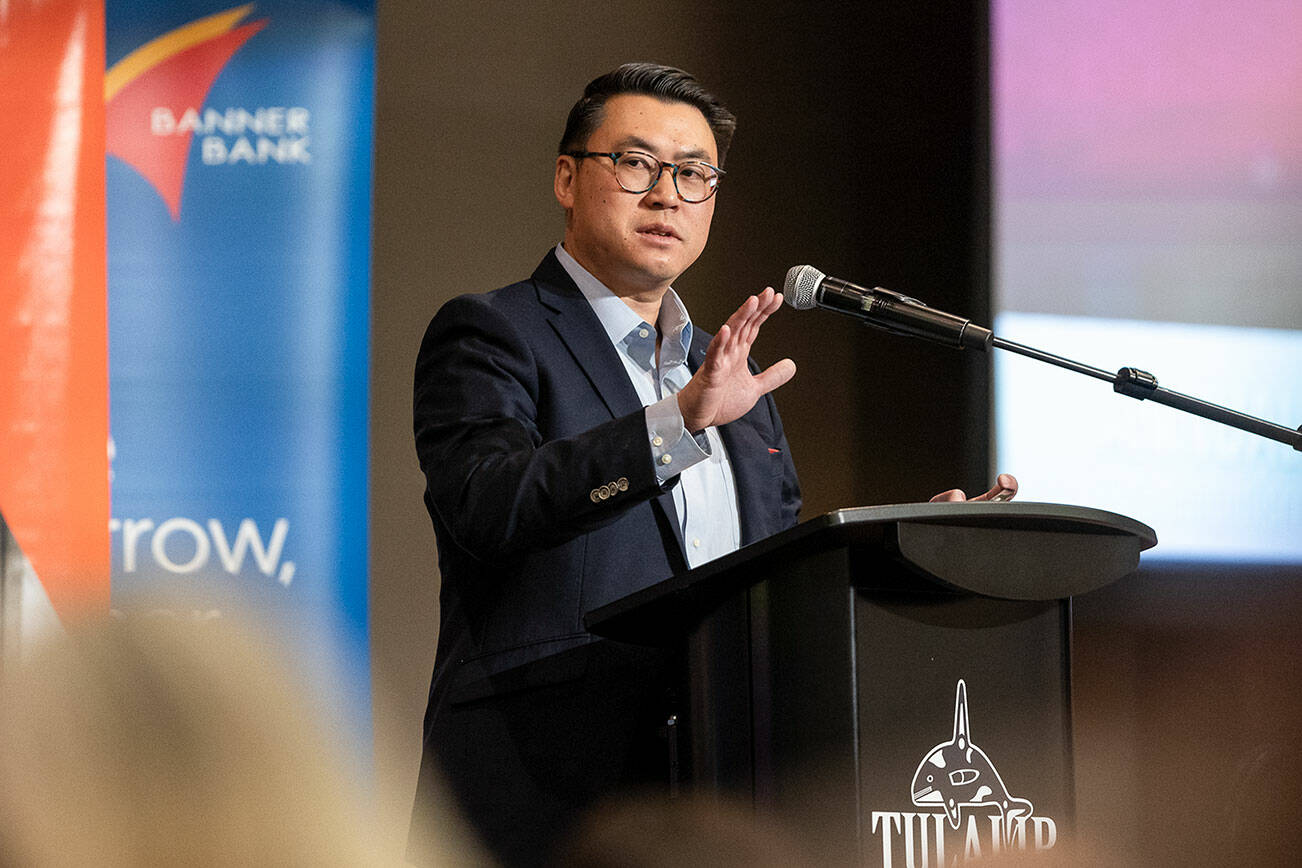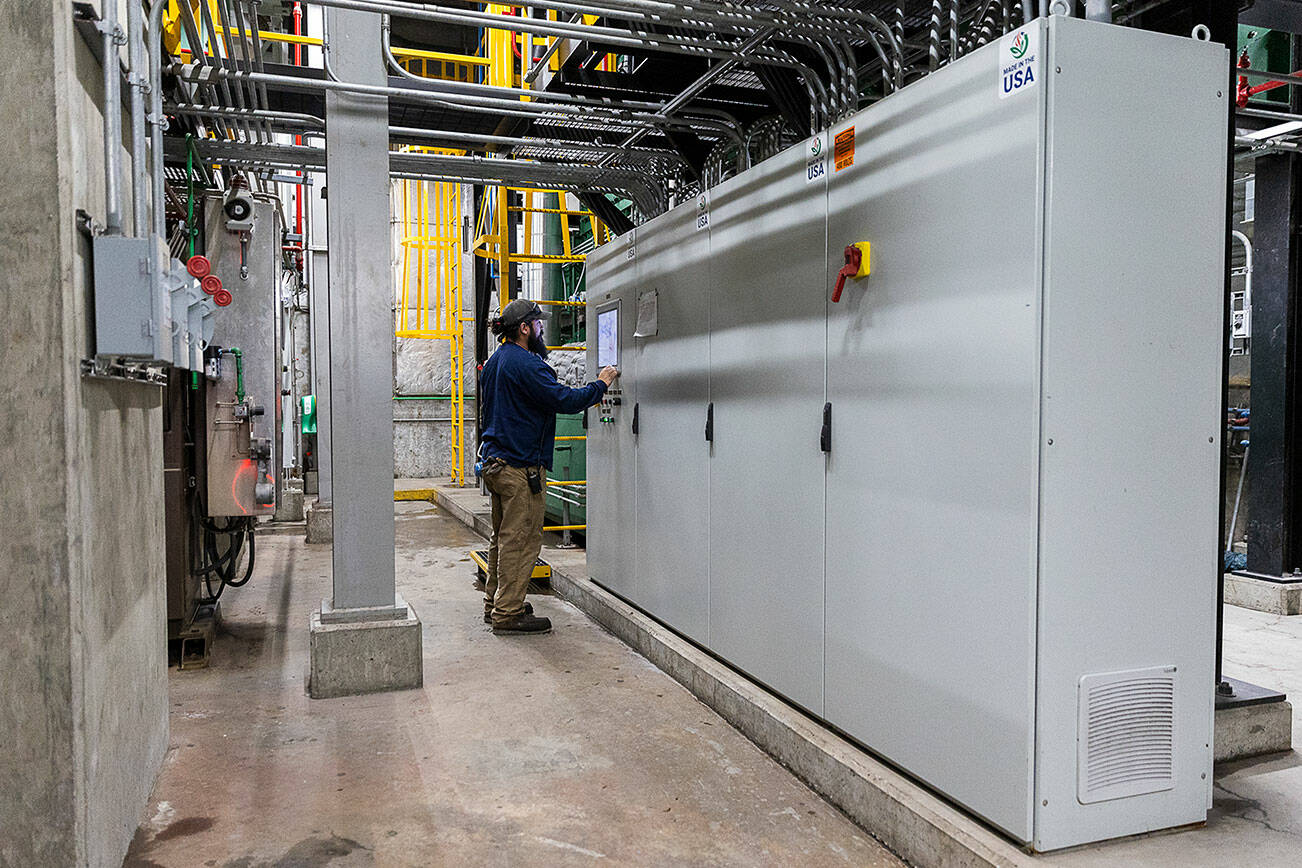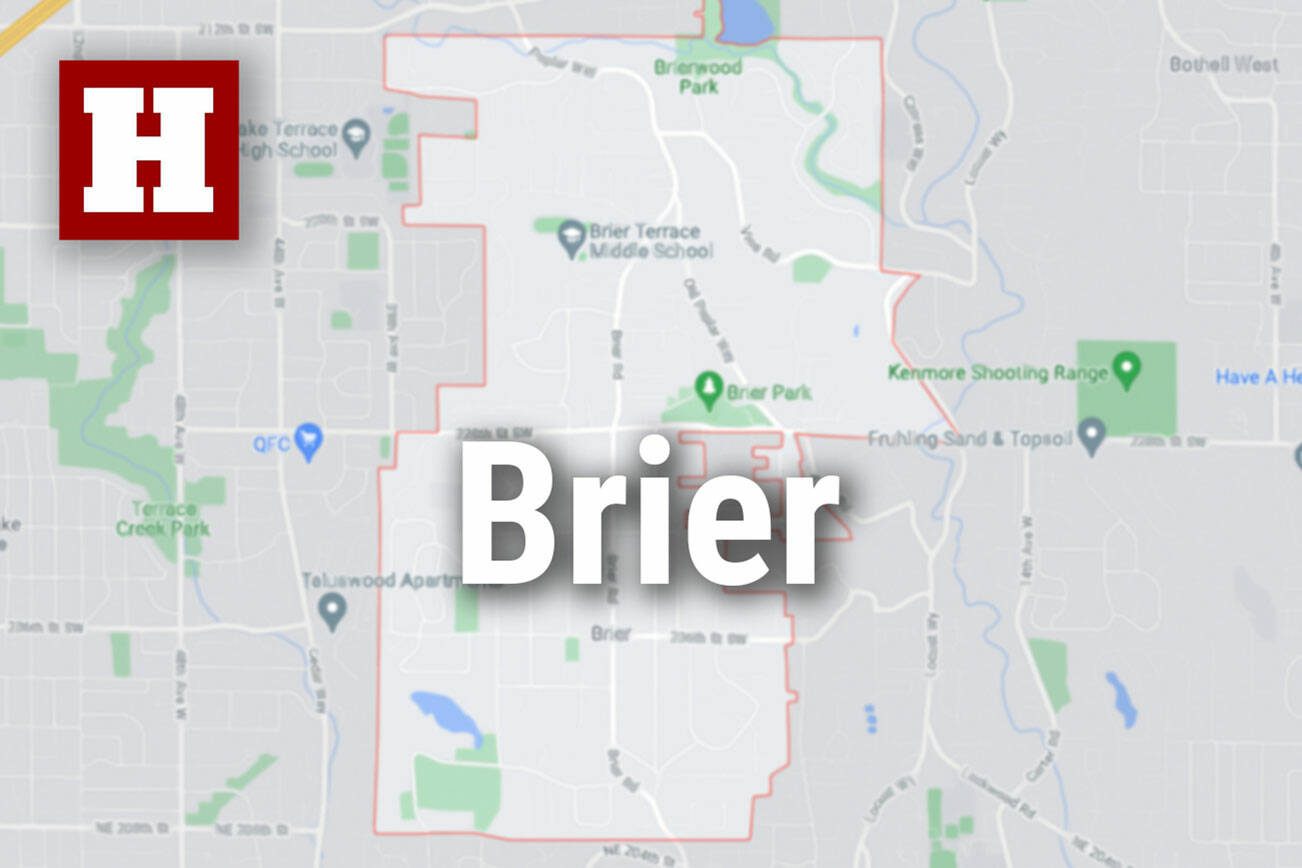EDMONDS — Overcrowded classes are triggering thousands of dollars in extra pay to teachers in the Edmonds School District.
And it’s going to be that way for some time.
On any given day there are more than 800 classes exceeding targets laid out in the contract between the district and its teachers’ union.
Each time, the teacher in the overcrowded classroom earns extra compensation, called trigger pay. Two quarters into the school year, the district has spent more than $800,000 on such payments.
But teachers don’t want trigger pay, Edmonds Education Association President Andi Nofziger-Meadows said.
“I don’t think anyone looks at it as bonus pay,” she said. “Trigger pay doesn’t make up for not being able to reach students individually because there are too many in the classroom.”
Trigger payments aren’t ideal, but they’re one of the district’s only tools in managing increasing enrollment, a budget shortfall and a shortage of classrooms, said Debby Carter, the district’s director of Human Resources.
“It’s not always that trigger (pay) is a negative thing,” she said. “There are factors outside of the perfect world of control you’d like to have to keep the trigger numbers down, but we also need to remain fiscally responsible. Just adding another teacher isn’t going to solve that situation.”
Nofziger-Meadows agreed that it’s not cost effective to add teachers when overcrowding is minimal.
“But in the position we’re in now, it’s not minimal,” she said. “Because of the class sizes, learning conditions aren’t as good as they were in the past few years.”
The district’s issues come months after school board directors approved layoffs and larger classes to offset a budget shortfall.
Teacher raises were one cause for the deficit, but Assistant Superintendent Greg Schwab said they had a much smaller impact than changes to state funding.
In Edmonds, trigger pay is doled out quarterly.
Class size goals for kindergarten through third grade are in the mid-20s. For grades 4 through 12, they range from the high-20s to the low-30s.
Nearly 1,000 classrooms exceeded those goals in the first weeks of the school year. By the end of November, the number was below 900 and the amount spent dropped 11%.
The majority of overcrowding occurs in secondary schools, because high school enrollment is more fluid than others, Schwab said.
Some students leave for Running Start classes at community colleges, Sno-Isle or other programs, so predicting how many students will stay on campus is difficult, he said.
At Meadowdale High School, since the start of the school year more than $100,000 has been shelled out in trigger pay to teachers — the most in the district.
However, elementary school teachers receiving trigger pay get an average of about $750 per class over the goal, nearly double the average stipend for middle and high school classes. The highest payment to an individual teacher in the second quarter was $4,400.
Higher-than-expected enrollment in Edmonds allowed administrators to add some teachers to the high schools and a few to elementary schools, with additional relief coming next semester when some of them will start.
Previously cut paraeducator hours have also been restored, but their salaries are still too low, Nofziger-Meadows said.
“We can hire them sometimes, but we can’t retain them,” she said.
Administrators also shift students in larger classes to smaller ones, but, they try to avoid that if possible.
“We’re all creatures of habit and we have our routines, but at the same time, it’s best to make sure the students are in classes that are manageable in terms of size,” Schwab said. “That’s the trade off.”
Nofziger-Meadows said additional staff should’ve been added at the beginning of the year to avoid disrupting students’ schedules.
Edmonds, the county’s largest school district, isn’t alone in dealing with overcrowding. How much teachers are compensated for trigger pay varies based on bargaining agreements between a district and its teachers’ union.
In Everett, class size goals were set at 24 students for kindergarten, 25 for grades 1 through 3, 26 for fourth grade and 27 for fifth grade.
Elementary school teachers are paid $15 per student, each day a goal is exceeded. In November, it worked out to the district paying $7,000 in extra pay among 73 educators.
Everett Education Association President Jared Kink said administrators have done a good job of keeping teachers in the district, but there just aren’t enough classrooms in elementary schools.
“But I think teachers overall would much prefer to have the lower classes sizes than the compensation,” he said.
At the middle and high schools, teachers aren’t compensated when their classes exceed size goals.
For grades six through eight, the goal for a teacher’s total student load is 174 over six classes, an average of 29.
In the high schools, the student goal is 150 over five classes.
November enrollment totals show 28 high school and 47 teachers are over district class-size goals.
At Gateway Middle School, about half the teachers are dealing with overcrowded classes.
In Mukilteo, the district’s class size goal for kindergarten through fifth grade is 23 students. In middle school classes, it is 25, and in high school, it is 27.
The district had 144 classes exceed those goals in the 2018-2019 school year and paid $300,000 in extra compensation.
More than 100 of the overcrowded classrooms were in elementary schools.
Human Resources Director Bruce Hobert said the issue in Mukilteo isn’t staffing, but classroom space.
Some classes are split between two teachers.
Other solutions involve shifting staff around the district.
If one school’s enrollment comes in higher than expected, administrators may move a teacher from one school to another.
All staffing and schedule changes are made during the first week of classes, Hobert said.
District and union leaders from all three districts said overcrowding woes could be fixed with more money from the state. They are pushing for changes in the public school funding model developed in response to the McCleary decision.
But if legislators don’t stick with one funding system then the state will be back in the same situation it was before McCleary, said state Sen. Marko Liias, D-Lynnwood.
Lawmakers are continuing to tweak the system, he said. They are looking to increase sums of money for special education and make it easier for districts to pass bonds to construct classrooms.
Some changes, like raising the amount districts can collect from local levies, are helping, but not enough.
Carter said she expects overcrowding to continue to decline in Edmonds, but the district will probably have some sort of trigger pay every year.
Nofziger-Meadows agreed, saying the district is heading in the right direction.
“But there’s still work to be done,” she said. “Bottom line is class sizes are still too high.”
Joey Thompson: 425-339-3449; jthompson@heraldnet.com. Twitter: @byjoeythompson.
Talk to us
> Give us your news tips.
> Send us a letter to the editor.
> More Herald contact information.
